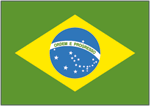 André Alves Leso and Guilherme Vinicius Jovanelli Moreira, in all likelihood, had never met Jefferson Firmino da Silva. But the three had more than a little in common. All were young, working class Brazilians. All were members of a torcida organizaa group, André and Guilherme of Mancha Alvi Verde (Palmeiras), Jefferson of Inferno Coral (Santa Cruz). And all now can be added to Brazil’s staggeringly long list of murder victims.
André Alves Leso and Guilherme Vinicius Jovanelli Moreira, in all likelihood, had never met Jefferson Firmino da Silva. But the three had more than a little in common. All were young, working class Brazilians. All were members of a torcida organizaa group, André and Guilherme of Mancha Alvi Verde (Palmeiras), Jefferson of Inferno Coral (Santa Cruz). And all now can be added to Brazil’s staggeringly long list of murder victims.
The deaths of André and Guilherme have attracted less public sympathy than that of Jefferson. André was shot in the head on a Sunday morning earlier this month, during a pre-arranged battle royale between Mancha Alvi Verde and Gaviões da Fiel (Corinthians) members in the north of São Paulo, several hours before that day’s clássico. He died in hospital two days later. Guilherme was beaten severely during the same briga, and also died in hospital a few days afterwards.
The confrontation along Avenida Inajar de Souza was considered a form of revenge for the death of Gaviões member Douglas Silva, whose body was found floating in São Paulo’s Tietê River last year. Around 500 men, carrying rocks, bats and sticks, and in some cases, firearms, took part. Opinions differ as to how the fight came about – some say it was agreed upon by both sides, while an official statement on the Mancha Alvi Verde website says that their members were ambushed on the way to the Pacaembu.
Either way, senior São Paulo police officer Margarette Barreto found it hard to see many innocent victims. We’re not dealing with little boys here, she said. They’re the type of individuals who rejected a police escort to the ground, and decided to provide their own escort, with guns…it’s hardly Little Red Riding Hood lost in the forest.
In response, the São Paulo Football Federation has banned the two organizadas from stadiums in the state, and police have seized computers from the groups’ headquarters. A number of men have been arrested, including at least one senior member of the Gaviões da Fiel.
Up in the nordeste, the circumstances surrounding the death of Jefferson, a young man with no criminal record, who was a baterista in the Inferno Coral’s drum section, were less complicated, and, depressingly, far more commonplace. On the night of February 15th he was, like most of the population of Recife, in the streets enjoying carnaval – in this case a bloco near his home in the lower class neighbourhood of Beberibe, under the shadow of Santa’s giant Arruda stadium. The bloco was set upon by a gang and wallets and cell phones were stolen. Jefferson retaliated and was severely beaten. He would die in hospital from his injuries two weeks later.
The differences and the similarities between the deaths of the three young men reveal a great deal about the nature of football violence in Brazil. To many, the torcida organizadas are simply a cancer: mindless, aggressive thugs, capable of often shocking acts of ultra-violence. There were 42 violent deaths in Brazilian football stadiums between 1999 and 2009, and countless more football related killings in the often semi-lawless favelas and periferias of the country’s major urban centres. A feud between the organizadas of Vila Nova and Goiás, for example, in the comparatively tranquil mid-western city of Goiânia, has left six dead in the past year. No Brazilian football season would be complete without at least a handful of stories about homemade bombs being smuggled into stadiums, pitched battles being waged in the streets after clássicos, or the training ground of a struggling side being invaded by furious members of an organizada.
Simple hooligans, then, similar to those who rampaged across Britain and Europe in the 70s and 80s, and the principle reason for the retreat of the Brazilian middle class football fan from the stadium to the safety of his or her sofa or barstool.
But just as UK and European society is a world away from Brazil, so the torcida organizadas are very different to their northern counterparts, both in behaviour and origins. To begin with, depending on the club, the organizadas can number not in the hundreds but in the thousands. They are generally the loudest, most vibrant section of a club’s support, and organise pounding drum sections, enormous flags, and ticker tape and “mosaic” displays. The ferocity of their vocal backing is often in sharp contrast to the more middle class sócios sections of the ground, where most of the noise comes from the unrelenting criticism of coach and players.
And when, during a disappointing season or a run of defeats, the rest of the ground stands almost empty (as it often does in Brazil, where fans tend to pick and choose their games), the part occupied by the organizadas usually remains heavily populated, if not full. They are, in some ways, the perfect football fans – vociferous, steadfast, and true.
The groups form alliances with other organizadas across Brazil (the Força Jovem Vasco, Mancha Verde, Galoucura (Atlético Mineiro) and Inferno Coral axis is one of the biggest), and, when the team of an allied organizada comes to town, attendance in the away end, supporting the visitors against a local rival, is obligatory. When the clubs of two allied groups play each other, the organizadas mingle together, swapping flags and t-shirts in a chummy enough atmosphere.
The organizadas can even play a positive role in wider society. More than a few of the bigger groups, including Galoucura and Força Jovem Vasco, organise social projects, from crèches to capoeira classes, in an attempt to improve the quality of life of young people in disadvantaged local communities.
In short, applying the most hopeful possible interpretation, the organizadas give a sense of belonging, and a feeling of self-worth, to thousands of young men from underprivileged backgrounds, who more often than not have only a rudimentary education, few worthwhile career prospects, and a distinct lack of parental guidance, or indeed any kind of positive role models at all.
So far, so good, then. Except that thuggery remains the bloodied carcass of the elephant in the room. Violence, and the inherent belief that the value of a life is terrifyingly cheap, is as ingrained within the torcida organizadas as it is in large parts of wider Brazilian society.
And yet handwringing over the horrors carried out by certain individuals within the torcida organizadas, as with the old British hooligan gangs, rarely goes beyond simple platitudes of the they’re just animals, not proper supporters stripe. Not particularly informative, or even useful, and certainly not an explanation that might lead to any kind of understanding of the problem.
What is undeniable is that a football crowd, violent or otherwise, is generally a reflection of the society that surrounds it. In this sense, it is hardly surprising that guns and other deadly weapons from time to time raise their ugly heads in organizada gangs. Though the figure has recently been creeping downwards, over the last 30 years there have been around 35,000 violent deaths per year in Brazil, a considerably higher figure than the average annual tally in many war zones.
The vast majority of these deaths come in the favelas and periferia, where most organizada members hail from. Given the violence prevalent in the streets away from Brazil’s football grounds, then, it is not hard to see why for some, the rules of behaviour inside and around the stadium should be similarly savage, particularly given the tribal atmosphere football can generate, and the copious amounts of alcohol and other substances consumed prior to kick-off.
Then there is the question of to what extent a torcida organizada is even a single unit at all. For one of the great dichotomies of the organizadas is the name – organised support. In truth, aside from a generally quite small central core, which numbers in the hundreds rather than the thousands, there is very little formal structure to the groups. Given that for many, membership simply involves buying an Inferno Coral or Mancha Verde t-shirt for a few reais, and standing in the same place in the ground and singing the same songs, how could there be?
Furthermore, many organizada members have spent their short lives battling against authority in all its forms, be it teachers or Brazil`s often extremely heavy-handed, unpopular military police. Why then, would they suddenly begin to listen to pleas for calm and order from the leaders of their own organizada? Fights, feuds and rivalries within the same organizada, based on gang or territorial divisions, are common, and the pleas of more senior members for calm often fall on deaf younger ears.
In short, there is often not much that is organised about the organizadas. As such, it is arguable to what extent a torcida organizada group as a whole, the official, stated aim of which may simply be to support the team, can be held responsible for the actions of certain individuals or subgroups within it.
It is not the intention of this article to make excuses for the violence that runs like a scar through the torcida organizadas. Any claims of being simply innocent, victimized supporters ring hollow when the acceptance, encouragement, or even active participation in criminal activity is tolerated within the groups and inside their clubhouses, and the excuses provided by societal factors have their limits. Neither does the violent imagery of organizada paraphernalia help much – the badge of the Inferno Coral boasts a machine gun-toting cobra.
A visit, this Sunday just gone, to the Vila Nova v Goiás clássico in Goiânia provides plenty of examples of the themes discussed here. Around 7,000 Vila fans are present, most of them massed along the side of the big Serra Dourada stadium. In their midst, the red and white uniforms of the Esquadrão Vermelho (“Red Squadron”) organizada are clearly visible, their drums supplying the rhythms for the chanting of the boisterous, bouncing supporters. A few hundred yards away, behind the goal, a smaller, rather more truculent bunch, has gathered, and spend their time casting balefully aggressive glances up at the larger group of supporters. This is Sangue Colorado (“Red Blood”), embroiled in a feud with Esquadrão Vermelho following a complicated saga of arguments and rifts.
After the game, which passes off peacefully enough, and ends in a 3-2 Vila win, the good-natured celebrations of the victorious fans are cut short by tear gas and baton rounds courtesy of the Goiânia choque riot police. Later that night, after an arrastão (“mugging wave”) by a Goiás organizada gang, a Vila Nova supporter is shot and killed in Parque Vaca Brava, a wealthy part of the city.
In closing, it is clear that the problem with torcida organizada violence lies as much with Brazilian society as it does with football. Widespread British hooligan behaviour was driven to virtual extinction by a number of factors, among them the increased ticket prices and the gentrification of the game brought about by the Sky TV/Premier League revolution, and greater police understanding and treatment of supporters in the wake of Hillsborough and other tragedies.
Similar gentrification of the Brazilian game is a long way off, particularly away from the sul and sudeste, though the new and renovated stadiums being constructed for the 2014 World Cup are likely to change the footballing landscape considerably. Whether the torcida organizadas will have a place in this brave new world remains to be seen. If the robbing, killing and vandalism can somehow be eradicated, then it is to be hoped that they will, as the Brazilian game would in many ways be a poorer place without them.
Footnote: The title of this article is taken from the novel of the same name by the late Irish writer John McGahern, and refers to the belief that the dead should be buried with their feet pointing to the east, the better to see the rising sun on judgement day.
By James Young
James’ blog can be found here






